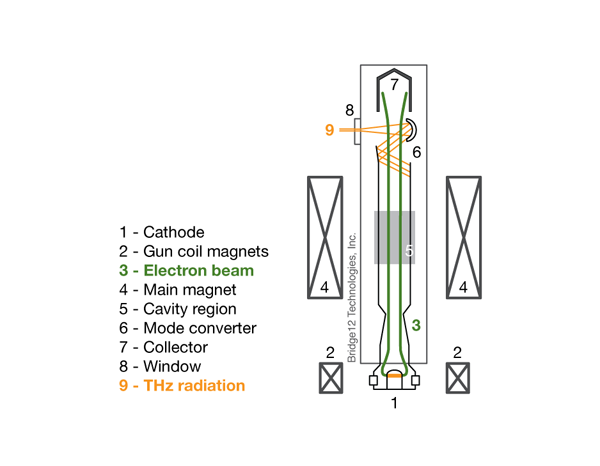A gyrotron is a vacuum electronic device (VED) capable of generating coherent high-power electromagnetic radiation in the microwave, millimeter wave and terahertz band. It operates on stimulated cyclotron radiation of electrons gyrating in a strong magnetic field typically provided by a superconducting magnet.
In a gyrotron, electrical energy is first converted to the transverse rotational energy of an electron beam. A large, overmoded (transverse dimensions = several wavelengths) resonator or a waveguide is used to convert this rotational electrical energy into electromagnetic waves. The frequency of the output radiation is a multiple (harmonic) of the rotation frequency of the electrons. For fundamental mode operation, the output frequency is ~ 28 GHz/T of magnetic field used. Gyrotrons operating in higher harmonics require a field reduced by the harmonic number. A schematic, depicting the various parts of a gyrotron tube is shown below.
 Electrons that are emitted by the cathode (1), are accelerated in a strong magnetic field of a superconducting magnet (4). While the electron beam (3) travels through the intense magnetic field, the electrons start to gyrate at a specific frequency given by the strength of the magnetic field. In the cavity (5), located at the position with the highest magnetic field strength, the THz radiation is strongly amplified. The mode converter (6) is used to form a free-gaussian beam that leaves the gyrotron through a window (8) and is coupled to a waveguide. The spent electron beam is then dissipated in the collector (7).
Electrons that are emitted by the cathode (1), are accelerated in a strong magnetic field of a superconducting magnet (4). While the electron beam (3) travels through the intense magnetic field, the electrons start to gyrate at a specific frequency given by the strength of the magnetic field. In the cavity (5), located at the position with the highest magnetic field strength, the THz radiation is strongly amplified. The mode converter (6) is used to form a free-gaussian beam that leaves the gyrotron through a window (8) and is coupled to a waveguide. The spent electron beam is then dissipated in the collector (7).
Why are gyrotrons powerful?
The gyrotron is a so-called fast-wave device because the dimensions of its interaction structure is much larger compared to the wavelength of the radiation. This is in contrast to slow-wave device, which have interaction structures that are of the order of the wavelength of the generated radiation. However, especially at high frequencies, these interaction structures can be very small (sub millimeter) and therefore is limited in their thermal handling capability. The overmoded resonator employed is a key distinguishing factor from other devices like klystrons and Traveling Wave Tubes (TWTs), which use structures with dimensions on the order of the operating wavelength. Hence, gyrotrons can produce power two to three orders of magnitude higher in the millimeter wave and terahertz frequencies than other devices.
Applications
* DNP-NMR
Radiation produced by gyrotrons is used to drive the Electron Paramagnetic Resonance (EPR) transition to enhance NMR signal intensity by a factor of several hundred. This allows researchers to perform protein structure determination experiments over 10,000 times faster. Read more about Bridge12’s DNP-NMR spectroscopy systems.
* Material Processing
Millimeter-wave gyrotrons are instrumental in the surface treatment and modification of materials, such as ceramics and metals, due to the uniform and localized heating of high-power microwave radiation. This rapid heating process significantly reduces material processing time and provides less of a chance of damage to the surface of the material than conventional heating methods. Read more about Bridge12’s material processing systems.
* Plasma Heating and Diagnostics in Fusion Machines
Gyrotrons are uniquely suited for the Electron Cyclotron Resonance Heating (ECRH) and Electron Cyclotron Current Drive (ECCD) of plasmas in magnetically confined fusion machines like tokamaks and stellarators. These processes heat the plasma and suppress plasma instabilities.
Gyrotrons can be an excellent source for plasma diagnostics such as microwave reflectometry, collective Thormson scattering and high-k scattering (Liu et al.) due to properties such as their frequency stability, narrow linewidth, and good spatial mode quality.